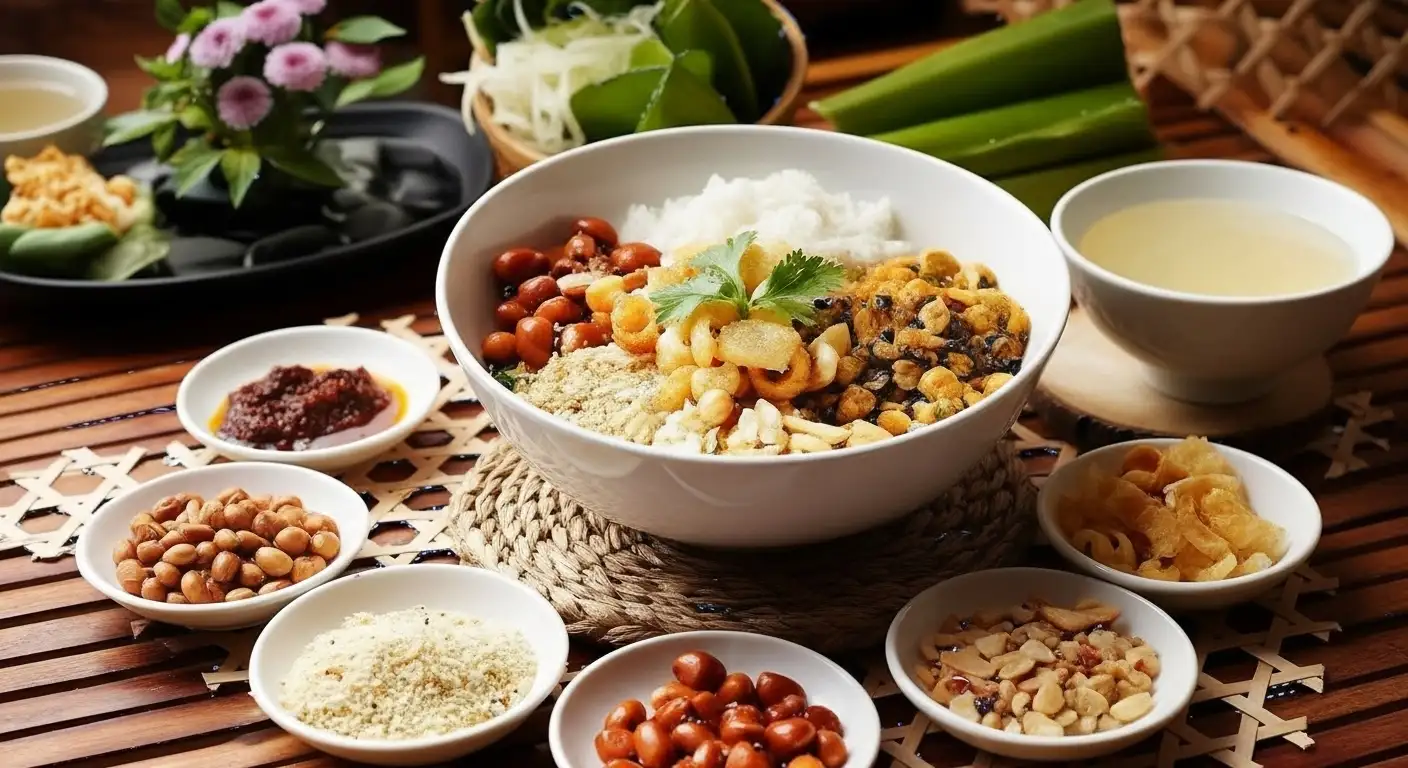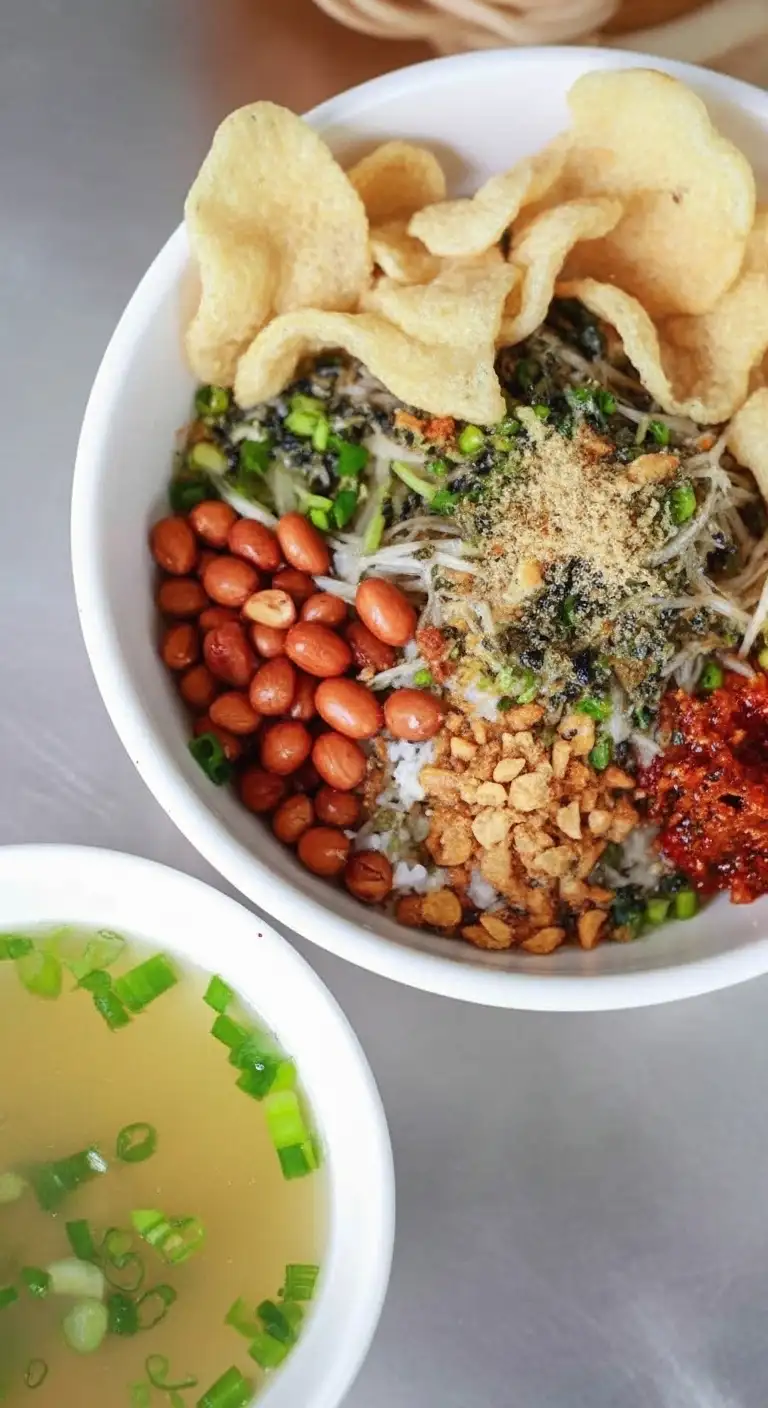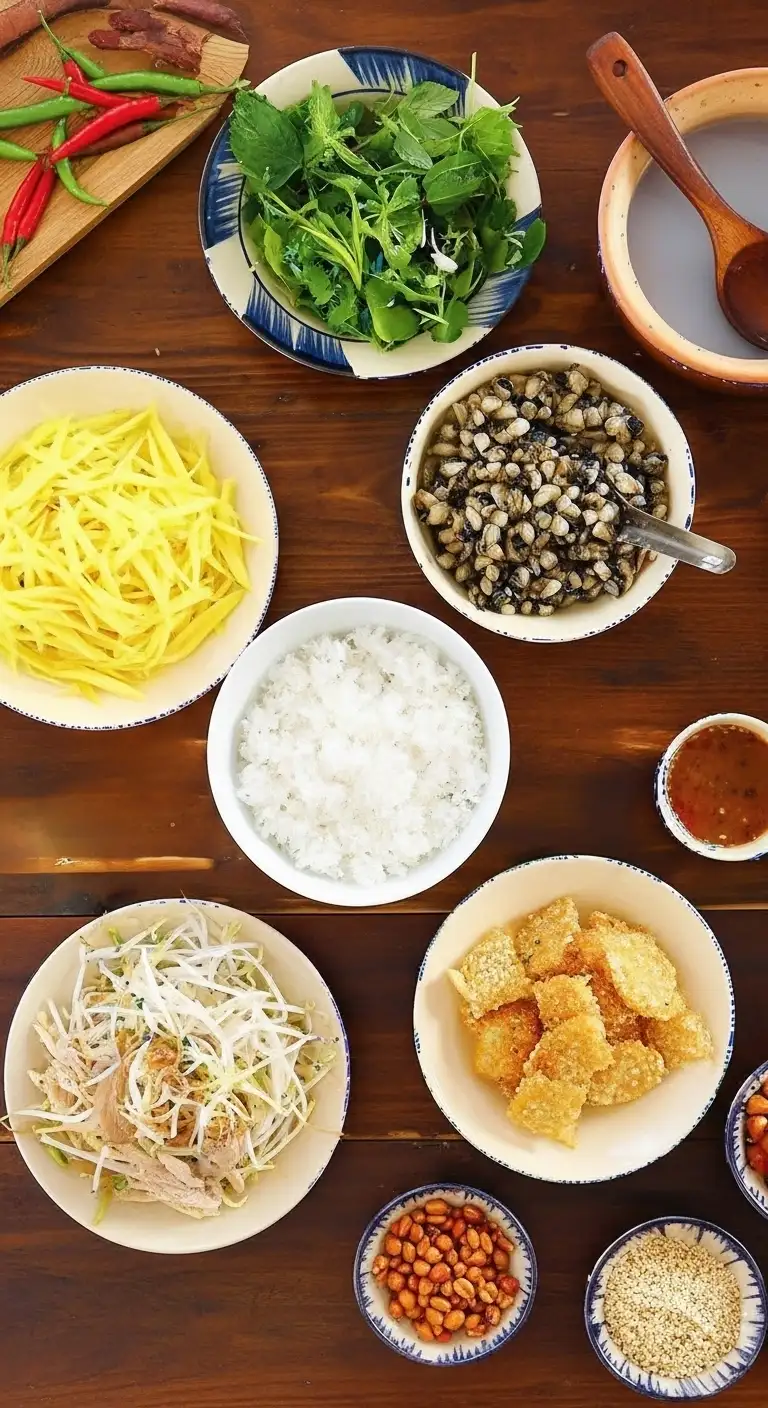Cơm Hến (pronounced “Com Hen”) is a quintessential specialty of Huế, the former imperial capital in Central Vietnam. It translates literally to “Clam Rice” or “Mussel Rice” and is a highly complex, textural, and flavorful dish that perfectly embodies the sophisticated, spicy, and sometimes subtle cuisine of the Central region.
Unlike many Vietnamese rice dishes that are served hot, Cơm Hến is characterized by its unique blend of temperatures—cold or room-temperature rice combined with piping hot broth and a multitude of spices and crunchy toppings.

Cơm Hến: The Basics
The Clams (Hến): The main protein is tiny river clams (or baby basket mussels) harvested locally, often from the Perfume River area. The clams are boiled, shucked, and then quickly stir-fried with chilies, oil, and spices, resulting in a savory, slightly spicy, and aromatic topping.
The Rice (Cơm Nguội): The base is plain steamed rice (cơm) that is deliberately served cool or at room temperature (cơm nguội). This cold rice creates a contrasting sensation when mixed with the hot broth.
The Broth (Nước Hến): The dish is served with a small bowl of clear, piping hot clam broth (nước hến), seasoned simply with salt and ginger.
The Toppings (A Symphony of Texture): The complexity comes from the numerous essential toppings, which include:
Crispy Elements: Roasted peanuts, fried pork rinds/cracklings (tóp mỡ), and sometimes broken pieces of sesame rice crackers.
Fresh Herbs & Vegetables: Shredded banana flower (hoa chuối), star fruit (khế), julienned green mango, taro stems (dọc mùng), bean sprouts, and various fresh herbs like mint and basil.
The Spice: The dish is heavily seasoned with fermented shrimp paste (mắm ruốc) and a liberal amount of chili oil or chili paste, true to Huế’s reputation for spicy food.
Variations of Cơm Hến
The core ingredients of clams and local spices remain, but the base can be swapped for noodles:
| Vietnamese Name | Base Ingredient | Description |
|---|---|---|
| Cơm Hến (Clam Rice) | Rice (Cơm) | The classic and most famous version. Features cold rice, stir-fried clams, and various toppings. |
| Bún Hến (Clam Noodles) | Vermicelli Noodles (Bún) | The rice is swapped for cold, thin white vermicelli rice noodles. This variation is equally popular and offers a lighter, slicker texture. |
| Mì Hến (Clam Noodles) | Egg Noodles (Mì) | Sometimes offered with quick-boil instant egg noodles, providing a springier texture than the rice vermicelli. |
| Cháo Hến (Clam Porridge) | Rice Porridge (Cháo) | A warm, comforting version where the clams are served in a thin, savory rice porridge, perfect for a cold morning. |

How to Eat Cơm Hến
The enjoyment of Cơm Hến lies in the dramatic contrasts of temperature, texture, and flavor.
Prepare the Bowl: The ingredients (rice, clams, herbs, peanuts, cracklings, and chili/shrimp paste) are placed in the bowl and should be thoroughly mixed before eating. The spicy, savory paste and annatto oil must coat the cold rice and toppings.
Add the Broth: This is the critical step. Take the small, separate bowl of piping hot, clear clam broth (nước hến) and pour it directly into the rice mixture. The hot liquid hitting the cold rice creates a unique warm-and-cold sensation.
Mix Again: Mix the ingredients once more to ensure the broth is integrated.
Eat Quickly: Cơm Hến is a dish to be enjoyed quickly with a spoon, embracing the immediate contrast of temperatures (hot broth, cold rice) and the explosion of flavors (spicy, savory, tart, crunchy).
Adjust the Spice: Be mindful of the chilies and shrimp paste added by the vendor—Huế locals favor extreme spice, so ask for a mild version (ít ớt) if you are sensitive to heat.
Regional Differences
Cơm Hến is definitively a Central Vietnamese creation and is one of the proud culinary symbols of Huế. It is tied to the local river clams and the specific, bold spice profile of the region.
| Region | Status & Interpretation | Key Difference |
|---|---|---|
| Central Vietnam (Huế) | The Origin and Authentic Home. Cơm Hến is found on almost every corner, often made by street vendors in the early morning. | Defined by the use of cold rice, the large number of fresh herbs (like taro stem and banana flower), the inclusion of fermented shrimp paste (mắm ruốc), and an intense spiciness. |
| Southern Vietnam (Ho Chi Minh City) | Available, but considered a regional specialty from Huế. | Southern versions may tone down the extreme spiciness and potentially reduce the amount of mắm ruốc (shrimp paste) to appeal to a broader palate. The rice might be served warmer, and the use of the specific Central Vietnamese herbs may be less common. |
| Northern Vietnam (Hanoi) | Rarely found in its authentic form. | Northern cuisine generally relies on simpler, lighter broths and less bold seasoning than the Central style. While Northern cuisine has rice and clams, this specific textural, spicy, and cool/hot rice salad is not part of its indigenous repertoire. |




